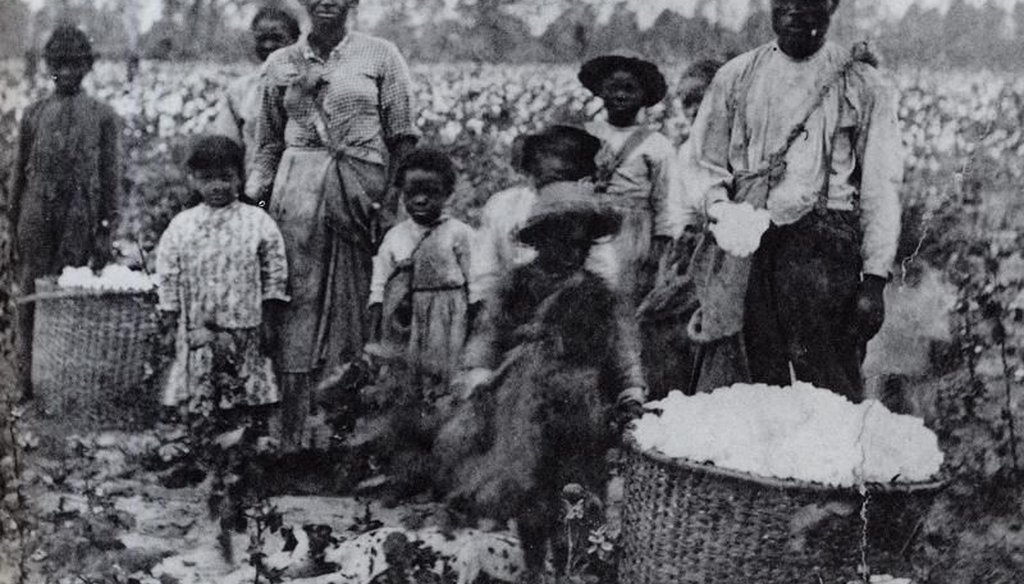Stand up for the facts!
Our only agenda is to publish the truth so you can be an informed participant in democracy.
We need your help.
I would like to contribute

Family of enslaved Black Americans in a field in Georgia, circa 1850. (Public domain)
If Your Time is short
-
Some Democrats did want to expand slavery westward, while the Republican party opposed it at the time of its creation.
-
But the division of the political parties wasn’t really the driver between who wanted slavery and who didn’t — it was the geographical division between the North and South.
Republican presidential contender Nikki Haley failed to use the word "slavery" when discussing the cause of the Civil War and the fallout from the misstep had lots of politicos talking about it.
That included former Wisconsin Gov. Scott Walker.
"Democrats wanted to expand slavery into western territories," Walker posted Dec. 28, 2023, on X. "Republicans opposed it."
Walker’s point seems to be that today’s voters should take that into account when making decisions now, many years later.
But this question is largely one for and from — the history books. And the narrow claim does not provide great insight for the political picture today, so we’re setting aside of Truth-O-Meter in favor of a deeper dive into the history.
Walker’s spokesperson, Jim Dick, pointed out that Democrats wanted to spread slavery west, and that Abraham Lincoln was the first successful Republican nominee for president. Of course, Lincoln went on to become a pivotal historical figure in slavery’s abolition.
"Upon his election, southern states dominated by Democrats (seceded) from the United States of America and formed the Confederacy," Dick wrote in a Dec. 29, 2023, email. "Jefferson Davis served as the President of the Confederacy. Previously, he was elected to the House of Representatives and Senate as a Democrat from Mississippi. His Vice President was Alexander Hamilton Stephens, a Democrat from Georgia."
The Republican Party was founded in 1854, with some historians (and the Republican party itself) pointing to Ripon, Wisconsin, as its birthplace. At the time of its founding, the country was bitterly divided over slavery. The Republican Party formed on the heels of the Whigs, which saw members desert to join the Southern Democrats. The anti-slavery Whigs joined the Republican Party, according to a timeline compiled by PBS.
The Missouri Compromise of 1820 had divided the country between the pro-slavery South and the anti-slavery North, according to a May 2020 USA Today fact-check. That compromise was instituted more than 40 years before the start of the Civil War in 1861.
In May 1854, Democrats in Congress passed the Kansas-Nebraska Act, which included a provision that would allow residents of the new Kansas and Nebraska territories to decide whether to allow slavery. The act effectively repealed the Missouri Compromise of 1820, and set into motion the Republican Party’s creation.
So, Republicans wanted to stop a Democratic piece of legislation. But were Democrats really a pro-slavery party?
Kind of, depending on where they lived.
Although the majority of Democrats did support expanding slavery, they weren’t exactly united in that support. The divide wasn’t between the Democrats and the newly created Republicans, the USA Today fact-check pointed out. It was the division between the country’s northern and southern portions that fueled the Civil War.
But Matthew Karp, an associate history professor at Princeton University, pointed out that although northern Democrats didn’t really want to expand slavery, they remained a part of a national party whose southern members did want the expansion.
"As a compromise, Northern Democratic leaders like Stephen Douglas sought to rally the party behind the idea of ‘popular sovereignty’ — that is, letting the (white) settlers of a new western territory decide the future of slavery, one way or the other," he said in a Jan. 5 email. "In practice, Republicans argued — accurately in my view — this amounted to permission for slavery to expand, first in Kansas Territory and then into the other western territories."
So, for Karp, the geographic location of Democrats didn’t really influence their choices, their political party did.
But while looking back at history is important, it’s likely not what voters are doing when making their decisions today. It’s also important to look at how things changed following the Civil War, and in more recent years, too.
Kathryn McGarr, an associate professor in the School of Journalism & Mass Communication at the University of Wisconsin-Madison, who is also affiliated with the History Department, pointed out the regional differences too, and then that there has been a shift since the Civil War for both of the parties. One example is the stance on equal rights.
"At the time of the Civil War, most members of what was then called the Democratic Party supported slavery, and most members of what was then the newly formed Republican Party were anti-slavery," she wrote in a Dec. 28, 2023, email.
"But what each party stood for has shifted dramatically over time, with the biggest realignments occurring in the middle of the Twentieth Century over civil rights. So someone like the segregationist senator Strom Thurmond was a Democrat until 1964 when he switched affiliation to the Republican Party."
In today’s political world, affiliations have shifted, and of course, now that slavery is illegal in the United States, neither party supports its expansion.
So, yes, Democrats supported expanding slavery at the outbreak of the Civil War. And the Republicans’ anti-slavery position stemmed from their geographical position in the northern portion of the country.
But in looking at those positions, and seeing how the parties have changed since the 1800s, voters have a whole new set of facts to look at. Including Republicans’ and Democrats’ stances on civil rights, for instance.
Our Sources
Scott Walker, X, Dec. 28, 2023
USA Today, "Fact check: Was GOP founded ‘to counter the Democrats’ plans to expand slavery?’, May 29, 2020
Email conversation with Kathryn McGarr, Associate professor at University of Wisconsin-Madison, Dec. 28. 2023
Email conversation with Jim Dick, spokesperson for former Wisconsin Gov. Scott Walker, Dec. 29 2023















































